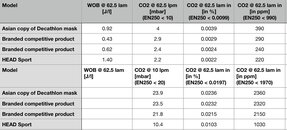Well, I spent some time yesterday going over the calculations to try to better understand what they really mean. To do this, I wanted to change the measurements to a value I could use to compare it to established standards. I know that the EU250 standard was 10 and 20 millibars, but that doesn't tell me much as an retired industrial hygienist. I needed that translated into parts per million (ppm) if at all possible. Well, it was possible, but I needed to make a couple of assumptions.
One was that these measurements were made at standard temperature and pressure (STP). I am using the American Association of Physicists in Medicine definition of standard temperature of 22 degrees C (72 degrees F), and 101.325 kilo Pascals (which is 1013.25 millibars). Dividing the measured level of CO2 in millibars by the atmospheric pressure in millibars of 1013.25 millibars will give us a percentage in the air, and then making the calculation will give us a reading in parts per million (ppm).
ppm = percentage in air x 1,000,000 / 100
Now, we in the industrial hygiene field use the American Conference of Governmental Industrial Hygienists' Time Weighted Average (TWA) for an allowed 8-hour concentration of chemicals. For carbon dioxide (CO2) in air for workers, this 8-hour TWA is 5000 ppm, with a Short-Term Exposure Limit (STEL) of 30,000 ppm. The highest reading that Mares measured in any of these masks was 2360 ppm using these assumptions.
Now, for my reservations; I am assuming that these measurements were made inside the nasal mask inside the Full Face Mask, which is what the person would have been breathing. I am also assuming the STP of sea level.
One other reservation I have is the assumption of a breath being about 4 liters, at the higher rate of 62.5 liters per minute (62.5 L/m). That gives about 16 breaths per minute. Looking at this, it indicates hard work, not a panicing swimmer. If we were to make other measurement of a breathing level of 1 liter per breath, and very rapid breathing, I think the results would be much higher levels of CO2 developing, as the snorkeler would be re-breathing most of his/her own breath and getting little outside air in some of these mask designs. There are a few masks which separate the inhalation and exhalation design within the snorkel, and it would be interesting to see what difference this makes is this scenario.





